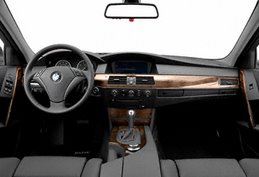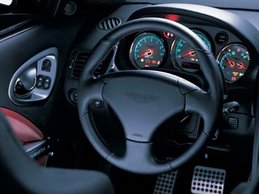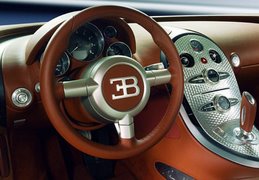 Aston Martin DB9 - After a day hammering the DB9 around the hills above Nice, France, it's hard not to agree with the passionate Bez, a rare automotive CEO who's as happy describing his steering philosophy ("As weighting increases away from the center point, I want to feel side forces in the steering") as he is talking about Aston's financial situation ("We are currently breaking even operationally and will be profitable in 2005").
Aston Martin DB9 - After a day hammering the DB9 around the hills above Nice, France, it's hard not to agree with the passionate Bez, a rare automotive CEO who's as happy describing his steering philosophy ("As weighting increases away from the center point, I want to feel side forces in the steering") as he is talking about Aston's financial situation ("We are currently breaking even operationally and will be profitable in 2005").Bez has every reason to be optimistic. With parent company Ford opening its wallet wide, Aston developed a flexible new platform—known internally as VH, for "vertical horizontal"—that is the basis for the DB9, in addition to next year's smaller V-8 Vantage and the 2007 replacement for the Vanquish.
Apart from retaining the Aston's V-12 engine—even though it's thoroughly revised via a new crank, cams, manifo
 ld, and engine-management system for more midrange torque—the engineers' clean-sheet game plan called for an all-new structure. They wanted 50/50 weight distribution, so they set the 444-hp V-12 well back in the engine bay, adopted a transaxle layout for the ZF six-speed automatic (you could pay more for the six-speed manual Graziano next year; the firm supplies Ferrari), and developed a bonded aluminum platform that's a mix of extruded, stamped, and die-cast parts. The front fenders and hood are composite, but the rest of the exterior skin is aluminum.
ld, and engine-management system for more midrange torque—the engineers' clean-sheet game plan called for an all-new structure. They wanted 50/50 weight distribution, so they set the 444-hp V-12 well back in the engine bay, adopted a transaxle layout for the ZF six-speed automatic (you could pay more for the six-speed manual Graziano next year; the firm supplies Ferrari), and developed a bonded aluminum platform that's a mix of extruded, stamped, and die-cast parts. The front fenders and hood are composite, but the rest of the exterior skin is aluminum.Happily, the DB9 driving experience matches the beauty. A welcome 5.8-inch stretch of the wheelbase means this is the first modern Aston to offer a respectably roomy driving position, with ample adjustment for the deep buckets and lovely leather steering wheel. If the rear seats remain token gestures at best, here at last is an Aston with a distinctive, special-place interior that's dominated by a sweeping central band of bamboo timber, 3-D aluminum instruments, and the rich smell of cowhide.
The first critical decision for the driver is to choose between changing gears manually via the steering-wheel paddles and selecting automatic "drive." For the DB9, ZF has doctored its familiar automatic, here called Touchtronic 2, so that it can perform like the electrohydraulic shift of the clutch-pedalless manual gearbox used in the Vanquish.

Aston's latest luxury vehicle rides more firmly than the earlier car, the DB7, especially at low speeds, but rewards the driver with far better control and agility. It stays flat through a series of corners, rarely unsettling the suspension over bumps, and encourages fast driving. If that's the trade-off for a ride that is clearly biased toward the firm, so be it.
No longer does the DB Aston live by beauty alone. This is the best-sorted, most thoroughly engineered Aston Martin of all time. Still, exquisite appearance remains central to its appeal. Combine this with a superb interior and authentic dynamic allure, and Bez's rationale stands up.













No comments:
Post a Comment